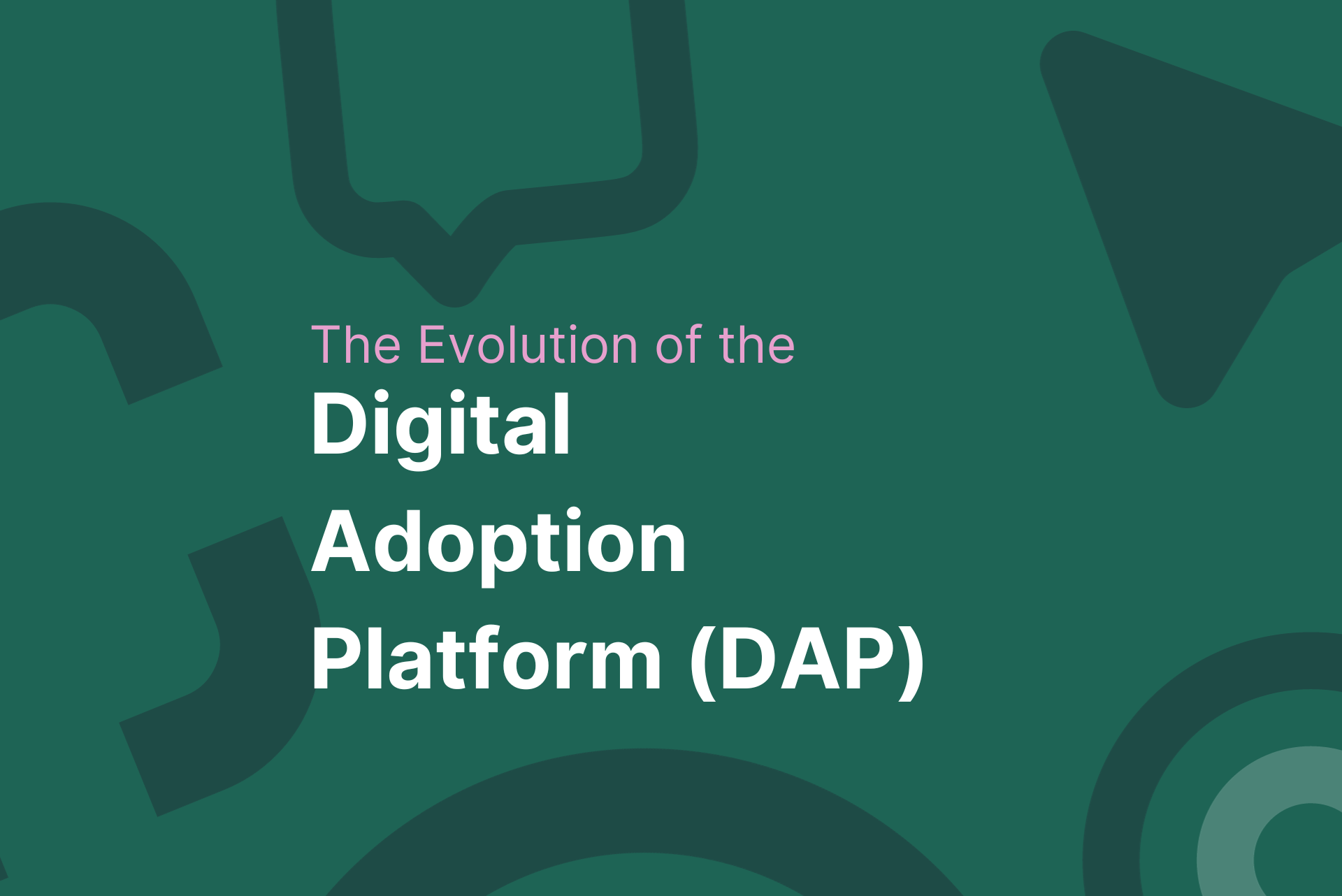The history of digital adoption platforms (DAPs)
As technology has advanced, the demand for a more streamlined approach to onboard users has grown. Enterprises recognized the need to address challenges in technology adoption, especially with the rapid development of new apps and platforms. This is where DAPs came into play, offering real-time guidance and insights based on user behavior.
The primary challenge that led to the emergence of DAPs was the difficulty in teaching employees or customers to use new applications. DAPs were designed to bridge this gap; acting as intermediaries to help users navigate and understand digital applications, breaking down complex jargon-filled environments. The main goal of a DAP was to facilitate the digital transformation of companies, ensuring that end-users could adopt new digital tools with minimal effort, leading to better overall employee engagement with new software.
Origins and early challenges
The concept of DAPs began to take shape in the early 2010s. During these early years, the idea of a platform dedicated to easing digital adoption was novel and not widely recognized. Many of the pioneering DAP companies faced skepticism and had to work hard to demonstrate the value of their products. The challenge was not just in creating an effective tool, but also in educating the market about its significance.
As digital transformation became a buzzword and companies started investing heavily in new software tools, the need for effective onboarding and training became evident. DAPs started gaining traction as they showcased their ability to reduce training times, improve user engagement, and enhance overall software ROI. By the mid-2010s, the benefits of a DAP for successful change management were becoming undeniable, leading to increased adoption across industries.
The shift in digital culture
The rise of DAPs also coincided with a broader shift in digital culture. As organizations underwent digital transformations, there was a growing recognition that simply implementing new software wasn’t enough. For true digital transformation to occur, user adoption, user proficiency, and employee engagement were crucial. DAPs emerged as the solution to this challenge, ensuring that investments in new software tools translated into tangible operational improvements.

The technology behind DAPs
The core of any DAP lies in the way the software understands and adapts to user behavior. Advanced analytics play a crucial role in this, providing data-driven insights that help tailor the guidance to individual users. Whether it’s a web app or desktop software, the primary goal remains the same: to promote efficient software and technology adoption and enhance the user’s learning experience.
Adaptive analytics and user behavior
A DAP should be designed to be intuitive and responsive. Central to this design is the digital adoption platform’s ability to harness adaptive analytics. These analytics engines continuously monitor user interactions, gathering invaluable data on user preferences, challenges, and behaviors.
By processing this data in real-time, a DAP can offer personalized support, ensuring that each user’s experience is tailored to their specific needs. This dynamic adaptability not only enhances user satisfaction but also accelerates the digital adoption process, ensuring that users learn and continue using the software with minimal friction.
Harnessing AI and IoT for enhanced user experience
DAPs are at the forefront of integrating up-and-coming technologies, like Artificial Intelligence (AI) and the Internet of Things (IoT), to enhance user experience. For instance, by leveraging AI, a DAP can offer predictive guidance, anticipate user needs, and provide proactive assistance.
IoT integrations also ensure that DAPs can offer consistent guidance across different devices, from desktops to smart devices. This convergence of technologies ensures that DAPs provide a seamless and intuitive user experience, irrespective of the platform or device.
Reliability and consistency
Employees commonly need to use dozens of tools and platforms to perform their day-to-day tasks. This commonly highlights the challenge of trust: if a tool is unreliable, people are less likely to use it on a daily basis. DAPs recognize the importance of trust in technology adoption. By prioritizing reliability, DAPs ensure that the guidance provided is not only accurate but also consistent.
Regular updates, transparent operations, and real-time feedback mechanisms are some of the features that a DAP employs to build and maintain user trust. When users know they can rely on a platform to guide them accurately, they are more likely to engage deeply, leading to successful digital adoption.
Aligning user tasks with technology
Every user approaches a software application with a specific objective in mind. DAPs excel in ensuring that the technology perfectly aligns with these objectives. By employing advanced analytics, digital adoption software can understand the specific tasks end-users aim to achieve.
This allows DAPs to provide guidance that resonates with user goals, ensuring a perfect task-technology fit. Such alignment not only enhances user satisfaction but also ensures continued engagement, as employees find the platform to be a valuable ally in achieving their objectives.
Easing the transition to new technologies
The technological horizon is full of emerging innovations. From AI to blockchain, we are constantly introduced to new tools and platforms. DAPs play a pivotal role in this introduction. Digital adoption software aims to demystify the complexities associated with new technologies, guiding users step-by-step through new processes and workflows.
By highlighting the benefits, showcasing the ease of use, and addressing potential risks, DAPs ensure that end-users are not overwhelmed. This guided approach ensures that users not only get introduced to but also embrace and excel in these emerging technological landscapes.

The synergy of in-app guidance, recording, and authoring in DAPs
DAPs are all about enhancing user experience within software applications. One of the reasons for their effectiveness is the seamless integration of in-app guidance with recording and authoring tools. This way, digital adoption software can be used for not just onboarding employees, but also to create context-specific process documentation – and keep it easily updated.
In-app guidance: The real-time assistant
In-app guidance is the real-time assistant that users interact with when navigating a software application. It provides contextual hints, walkthroughs, and tooltips, ensuring users have the necessary support when learning how to use new software. This real-time assistance reduces the learning curve, ensuring users can efficiently utilize the software without getting overwhelmed.
Recording technology: Capturing processes
Recording technology is pivotal in automating content creation within a DAP. By simply recording processes, DAPs can auto-generate step-by-step instructions, interactive videos, and even virtual assistants. This ensures that the guidance provided is tailored to the exact processes and workflows of the software, making it highly relevant and user-centric.
Authoring tools: Crafting customized content
While the recording technology captures processes, authoring tools in DAPs allow for the customization and enhancement of this content. They enable the creation of interactive scenarios, the addition of multimedia elements, and even the translation of content into multiple languages. This ensures that the in-app guidance is not just accurate but also engaging and accessible to a diverse user base.

Real-world applications of a DAP
Almost every organization, regardless of its size, relies on various software platforms to manage its operations. The challenge of successful digital transformation lies in ensuring that employees not only use these platforms but also utilize them properly.
Sales management systems
Let’s consider a sales team transitioning to a new sales management system. While the tool promises to streamline sales processes and improve customer relationships, its various features can be overwhelming for sales reps at first. A DAP can guide the employees through lead creation, sales funnel management, and even advanced analytics, ensuring they harness the full potential of the tool, leading to increased sales and improved customer relations.
Enterprise Resource Planning (ERP) systems
Large organizations often face challenges when implementing comprehensive ERP solutions. The complexity of managing finances, inventory, and supply chain operations can be daunting. With a DAP, employees receive real-time guidance on tasks like invoice processing, financial reporting, and inventory management. This effective end-user training in ERP implementations not only reduces errors but also ensures timely and efficient operations.
Customer service platforms
Customer support teams, when introduced to a new customer service platform, need to navigate ticketing systems, customer databases, and knowledge bases. A DAP can simplify this by offering in-app guidance on handling customer queries, managing tickets, and accessing relevant customer data, ensuring swift and effective customer support.
Marketing automation tools
Marketing teams aiming to leverage a new marketing automation tool might initially struggle with setting up campaigns, managing leads, or analyzing marketing data. A DAP can guide marketers through these processes, from campaign creation to lead nurturing and analytics interpretation, ensuring optimized marketing efforts and better ROI.
Field service management systems
Field service teams, responsible for on-site customer services, can benefit immensely from advanced field service management systems. However, understanding scheduling, resource management, and customer data on the go can be challenging. DAPs provide real-time assistance during software onboarding, helping field agents access customer data, manage schedules, and even handle on-site invoicing, enhancing service efficiency and customer satisfaction.
Beyond traditional DAPs: Emerging trends and innovations
As AI and machine learning become more integrated into our daily tasks, DAPs will likely incorporate these technologies to offer even more personalized guidance. The focus will shift from mere software adoption to driving adoption in a way that aligns with the organization’s broader goals.
AI-powered personalization
One of the most significant advancements in DAPs is the integration of artificial intelligence. With AI, a DAP can analyze vast amounts of user data in real time, understanding individual user behaviors, preferences, and challenges. This allows DAPs to offer guidance that is not just generic but tailored to each user’s specific needs. For instance, an AI-powered DAP can predict areas where a user might face challenges based on past behavior and proactively offer guidance even before the user encounters an issue.
Adaptive learning paths
Building on the capabilities of AI, DAPs are moving towards creating adaptive learning paths. Instead of a one-size-fits-all approach, these paths adjust based on the user’s progress, expertise, and needs. If a user quickly grasps certain concepts, the DAP might offer advanced guidance or skip basic tutorials. Conversely, if a user struggles, the DAP can provide additional resources or simplify the guidance to ensure comprehension.
Workflow learning integration
Workflow learning is the concept of integrating learning directly into the flow of work. Instead of separate training sessions or courses, learning becomes a continuous process that happens as users perform their tasks. DAPs are perfectly positioned to champion this approach. By offering guidance directly within the software or tool, DAPs ensure that users learn by doing, leading to better retention and application of knowledge. This seamless integration of learning and work ensures that employees can immediately apply what they learn, enhancing efficiency and productivity.
ClickLearn CEO Joachim Scheirmacher recently discussed how software training is changing, highlighting the importance of embracing workflow learning strategies in digital adoption.
Aligning with organizational goals
The next generation of DAPs will not just revolve around software adoption but will also ensure that this adoption aligns with the broader goals of the organization. Whether it’s improving customer satisfaction, increasing sales, or enhancing operational efficiency, DAPs will play a role in ensuring that software usage directly contributes to achieving these objectives. By analyzing organizational data, DAPs can offer guidance that not only helps employees navigate software but also steers them toward actions that align with the company’s strategic goals.
